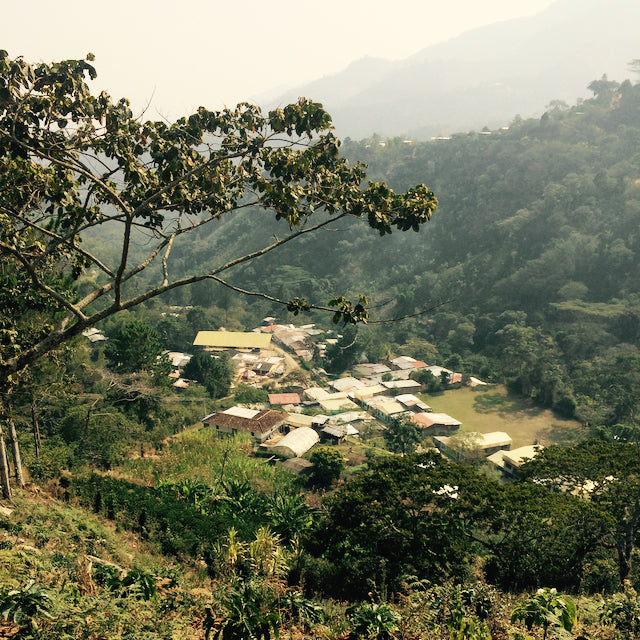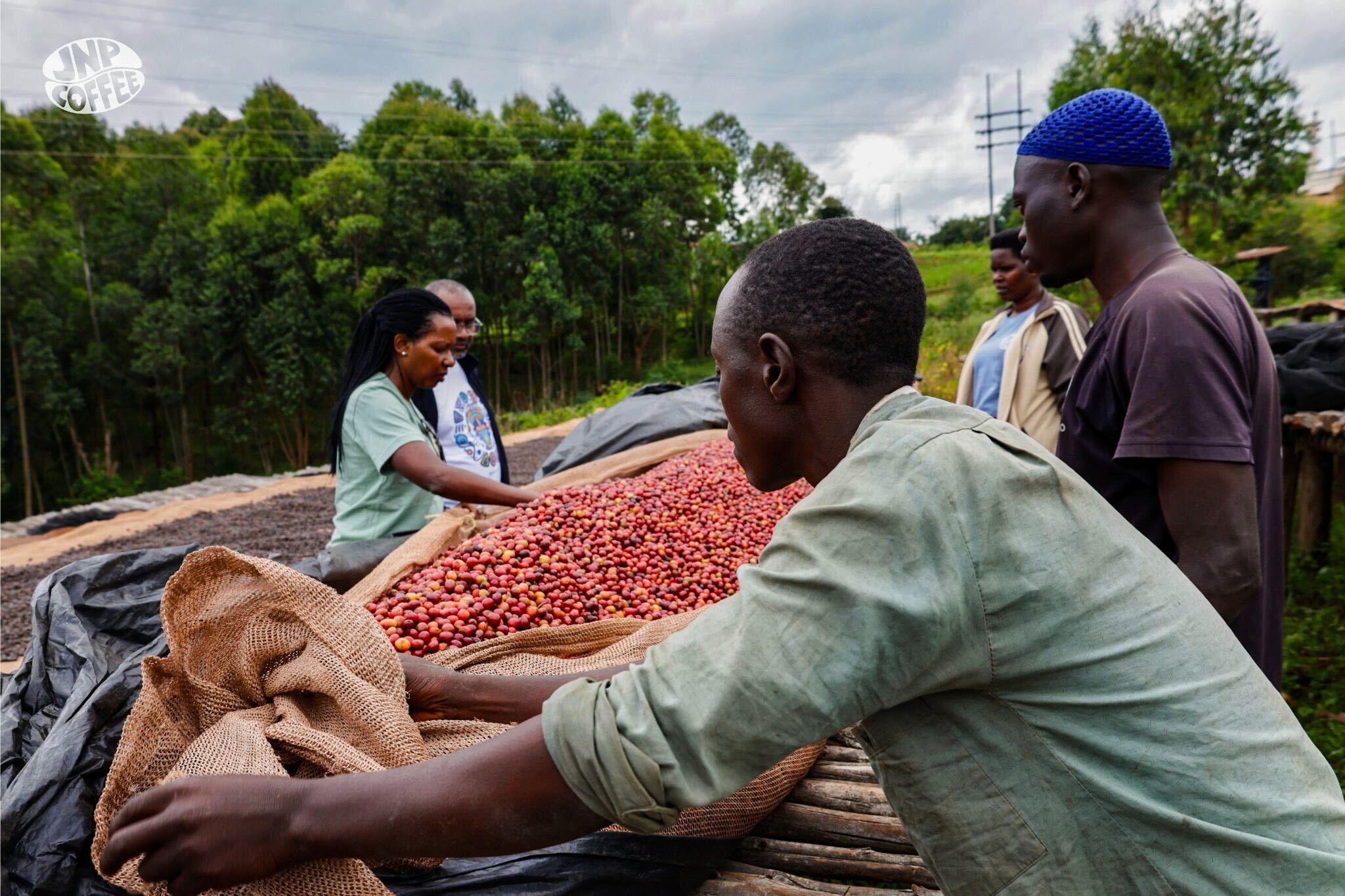Our Green Coffee Buyer, Sam, works hard to help source some of the best coffee available, and this effort pays off with each exceptional coffee release. There are a myriad of factors that affect each sourcing and roasting decision, and we want to help clarify this process by highlighting a few of the most common questions we receive, as well as some of the unique particularities surrounding different producing origins. See Sam's answers below!
Will a coffee taste a certain way just because it's from a particular origin?
Not necessarily! You could make a broad generalization about certain regions or countries of origin and the flavor profiles they’re best known for. Many people associate Ethiopia with fruity or floral coffees, for example, and that can get more specific within individual regions—I associate washed coffees from Guji with stone fruit and jasmine and washed coffees from Yirgacheffe with citrus and chamomile, for example.
But break it down and we’re really talking about a litany of other factors - soil composition, variety, and climate contribute to “origin characteristics,” but so do economic, social, and historical influence.
Take somewhere like Burundi, which produces some of my personal favorite coffees. Nearly 100% of the coffee grown in Burundi is East African red bourbon or a closely-related sub-variety… a product of Belgian colonial planting that has been reinforced by a modern commitment by the Burundian government to preserve the qualities that differentiate its most important cash crop. Most farms here are miniscule garden plots, too small to sell coffee in isolation, and so processing happens on a large scale at centralized washing stations. Finally, even among coffee growers, tea is the usual drink of preference - it’s more affordable and hasn’t inherited the negative association coffee has held since the colonial era.
All of this together results in circumstances where Burundian coffee is produced in a manner that looks more homogenous - differentiation is according to processing and location, which could be the washing station, region, or hill (one of the smaller administrative units of Burundi). The coffees are delicious and you absolutely see a difference from region to region or station to station - but in broad strokes, a lot of the variables that could more broadly impact flavor are controlled by both intent and circumstance.
By contrast, in Colombia, it is common even for small-scale growers to process their own coffee on the farm with smaller-format machinery - the resulting “parchment coffee” can be stored for a longer period of time, and therefore can be isolated with ease. Coffee is consumed widely throughout the country and it is not uncommon for producers to taste their own coffee (or to have direct feedback from somebody who did). A few varieties are well promoted, but far more are grown, including many that are colloquially known but not formally identified (like chiroso, papayo, caturron, borbón de la montaña, aji borbón, and so on).
You still have the more traditional flavor profiles, especially in large format coffees - citrus and caramel in Huila excelsos, maybe - but far more differentiation in smaller lots and more financial and logistical opportunity for experimentation.
Can certain varieties only grow in particular regions?
Sort of, for agricultural, geographic, and political reasons.
Different varieties succeed in different microclimates and soil conditions, while they respond differently to stressors like drought and pests. If a producer in, say, Alta Verapaz, Guatemala got access to SL-28, it isn’t certain that the drought-tolerant variety would fare well in the region’s cloud forests, much less retain the blackcurrant-like flavors it is known for in Kenya. You could certainly grow it if you had access to seeds or seedlings, but not without significant opportunity cost (as it takes 3 or more years for a new plot to become productive).
Then, of course, there are the logistical challenges - legally, getting seeds or seedlings across national borders is complicated due to phytosanitary regulations. Hence from country to country, you tend to see some variation in the mix of varieties grown - if you’re a farmer in Honduras, it’s far easier to gain access to a common variety like catuai or a Honduras-specific variety like parainema than it is to gain access to a Colombia-specific variety like pink bourbon.
How are producer relationships formed? Why is this important in the process of sourcing coffee?
Historically, for a lot of companies like ours, importers facilitate these relationships. If you’ve been a steady customer of a particular coffee, and want to invest further in that supply chain, your importer may offer to introduce you to the producer, which could mean the exporter or an individual farmer. Usually, for a direct trade relationship to work, it requires all of these parties - importer, exporter, farmer, and roaster - to work together on a consistent basis from one harvest to the next.
Some of our most successful farm relationships began with large-format purchasing. Knowing that we like coffees from, say, the north of Huila as reliable blend components, we could look at individual deliveries from that region and identify a farmer whose coffee we really like and buy their coffee for our single origin menu. If all goes well, it becomes much easier to commit to their coffee every year.
In this day and age, social media, WhatsApp, and translation apps facilitate things really quickly!
What are the main condition differences between particular regions (weather, harvesting, processing, group washing stations, etc.)? How do these conditions affect the coffee?
In addition to some of the factors we talked about above - soil composition, the mix of varieties grown, the relative scale of processing - latitude, elevation, and climate are all important.
Latitude and elevation are interrelated. A main reason is what’s called diurnal temperature range. At a given latitude, the ideal temperature range for coffee exists at certain elevations. The closer to the equator you are, the higher you need to go to find land that does not experience frost, but also does not get untenably hot. At the equator this may be 2,000 meters or higher; in Guatemala or Honduras, you’ll find similar climatic conditions closer to 1,600 meters; in Brazil’s coffee regions it might look like 1,100 meters.
Circumstantially this impacts other variables too - there is not much land available at 2,000 meters, and what is available is steep and difficult to access, and it may be far away from a port or a dry mill. The coffee may be beautiful, but the logistics of producing it are more limiting - small plots, no tractors, challenging to access.
Climate is relevant too - not just temperatures, but rainfall patterns and intensity. Well-timed rains are necessary for general plant health, but they also determine when the coffee will flower and whether those flowers will fixate and ultimately result in fruit development. But excessively heavy rains can negatively impact both yields and quality, and rains during the harvest period, particularly while coffee is drying, can be disastrous - especially in somewhere with an otherwise consistent dry season where coffee may be dried in open sun.
Some regions will have a very well defined rainy and dry season, which makes for a more concentrated, more predictable harvest season. Others have prolonged wet seasons with constant cloud coverage and steady rain - which could spread out flowering, and therefore the harvest season, while also impacting how producers are able to process their coffee - often with more mechanical drying and less production of honey and natural process coffees.
Finally, as mentioned before, local circumstances and traditions play a role - for example, in what style of processing is popular in a particular area, in access to water for processing, in availability of seasonal labor. Even more oblique cultural factors, like how people think about plant health, can have an impact.
Why are coffees from certain origins more popular/more sought after? How has the expanding specialty coffee industry and social media had an influence on this?
Naturally production capacity plays a role - Brazil and Colombia are the biggest producers of arabica coffee, so it’s little surprise that those are the most demanded origins in the U.S. by import value.
In specialty coffee’s infancy - between the rise of premium cafe chains in the 60s and 70s and the early days of direct trade in the decades following - there was a rather effective shift towards promoting coffee origins. Consumers became more aware, if only superficially, that marks like “Ethiopia Misty Valley” or “Guatemala Antigua” were indicators of quality (though today, we’d view those marks as generic). Some exporting countries invested heavily in supporting these reputations, too, regulating what coffees could be sold under what branding according to how well they matched the typical quality and flavor profile of a region.
As traceability improved, so has consumer education and “brand awareness” of different regions or origins - Honduras is a great example of a country with delicious and well-differentiated coffees that 20 years ago didn’t have the same reputation for quality that its neighbors held. This is, in part, due to the influence of competitions like the Cup of Excellence, but it’s also due to more and more consumers having a positive experience with single origin coffees from Honduras, and in turn seeking those out in the future.
Reputation and quality are mutually perpetuating: good quality is rewarded with good prices, which motivate more producers to focus on quality, which reinforces positive consumer expectations and creates more demand. I don’t want to malign any particular country or region, but we often see this pattern in inverse: the perception that a particular country or region produces coffees of lower quality, which leads the market to discount those coffees, which reinforces some of the factors negatively impacting quality.
How often does Partners' blend components change, and how do you keep the same flavor profile for certain coffees?
The countries of origin remain pretty stable. The challenge there becomes maintaining seasonality - if Guatemala or Honduras only have one harvest period each year, we need to structure our purchasing accordingly - making tight projections about our inventory needs, while strategizing how to extend that season as long as possible. Sometimes that means sourcing from multiple elevations or regions within a single country that harvest earlier or later due to climatic differences.
Something useful about blends is that you don’t need to change every component at once; making adjustments incrementally helps maintain stability even as components rotate in and out.
When sourcing coffee, are there any regions that Partners does not work with? And if so, why?
There’s several regions we don’t source coffee from - not because of any deficiency in their coffee, but because we’ve chosen instead to focus more deeply on fewer origins. Currently most of our sourcing is concentrated in continental Latin America, Ethiopia, and East Africa - there are some spectacular coffees to be found elsewhere that simply don’t make sense for us at this time.
When we do expand our sourcing to a new country of origin, we try to do so with this philosophy in mind: looking at supply chain partners that make good logistical sense, fill a tangible need on our menu, and appear to be a sensible and values-aligned partner for us in the long term. Perú is our best recent example: improving the seasonality of our menu by bolstering our sourcing in the Southern Hemisphere, while allowing us to work with sourcing partners who share our quality and sustainability ideals.
Have even more questions? Check out our FAQ page or send us an email to help@partnerscoffee.com!








Leave a comment
This site is protected by hCaptcha and the hCaptcha Privacy Policy and Terms of Service apply.